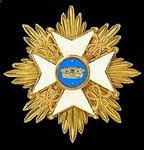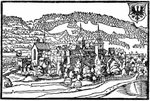As it has been taking so long to write up the backlog of Prussian flags, here is another French flag with a mercifully short write up.
The first set are as depicted on the 1757 manuscript illustration.
The second set are as described in the French 18th century regulations and by Pierre Charrié:
In 1721 the flags were depicted as without the ship and with a far greater number of gold fleurs de lys. I have taken the design of the ship from the 1757 manuscript illustration; in the regulations throughout the 1740s and 1750s the ship is described as gold, although almost all modern illustrations use a coloured version, as described by Pierre Charrié.
Royal Des Vaisseaux was first raised for sea service in 1638. It had 2 battalions in the Seven Years War.
The regiment was very active in the War of the Spanish Succession and the War of the Austrian Succession. Its Seven Years War was rather quieter.
In 1756 it was encamped at Granville. Fifty men under the command of the chevalier d'Eyrauges on the Iles Chaussey were attacked on the 19th July by a British squadron. For defence d'Eyrauges and his men had only an uncompleted fort and a single cannon. However, the defence was maintained so convincingly that the British were persuaded to give them the honours of war and conveyed the detachment to the mainland. The regiment spent the winter at Coutances and Bayeux and then in 1757 moved to the coast of Saintonge (on the Atlantic coast). It was in Brittany in 1758 and in that year at the battle of Saint-Cast on the 11th September where Captain La Canorgue was killed (see for the battle: https://en.wikipedia.org/wiki/Battle_of_Saint_Cast and http://www.kronoskaf.com/syw/index.php?title=1758-09-11_-_Combat_of_Saint-Cast). The battle was disastrous for the British and was the last British attack on mainland France in the war. As British MP Henry Fox said specifically of the raid on Rochefort in September 1757 but in general of the British policy of raiding the French coasts, it was like "breaking windows with guineas", that is to say, much effort and expense (of money and lives) for very little gain. (A guinea was a coin in the old British Imperial currency worth 21 shillings or one pound one shilling. I remember in the pre-decimal 1960s that expensive academic books were often priced at 63 shillings or 3 guineas.)
Royal-Vaisseaux occupied in succession the towns of Dinan, Niort, La Rochelle and Bayonne, all on the western coast of France. In 1762 the regiment was part of an auxiliary corps sent to Spain to fight against the Portuguese. Returning to France at the beginning of the following year, it occupied first Montlouis and Villefranche and then moved on to Toulouse in May 1763.
(Much of the text above is taken from Susane Volume 5, with additional text by me.)
And this is the illustration of the uniform (and flags) from the 1757 manuscript:




















